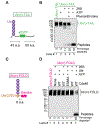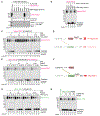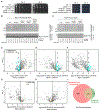Bidirectional substrate shuttling between the 26S proteasome and the Cdc48 ATPase promotes protein degradation
- PMID: 38401542
- PMCID: PMC11995671
- DOI: 10.1016/j.molcel.2024.01.029
Bidirectional substrate shuttling between the 26S proteasome and the Cdc48 ATPase promotes protein degradation
Abstract
Most eukaryotic proteins are degraded by the 26S proteasome after modification with a polyubiquitin chain. Substrates lacking unstructured segments cannot be degraded directly and require prior unfolding by the Cdc48 ATPase (p97 or VCP in mammals) in complex with its ubiquitin-binding partner Ufd1-Npl4 (UN). Here, we use purified yeast components to reconstitute Cdc48-dependent degradation of well-folded model substrates by the proteasome. We show that a minimal system consists of the 26S proteasome, the Cdc48-UN ATPase complex, the proteasome cofactor Rad23, and the Cdc48 cofactors Ubx5 and Shp1. Rad23 and Ubx5 stimulate polyubiquitin binding to the 26S proteasome and the Cdc48-UN complex, respectively, allowing these machines to compete for substrates before and after their unfolding. Shp1 stimulates protein unfolding by the Cdc48-UN complex rather than substrate recruitment. Experiments in yeast cells confirm that many proteins undergo bidirectional substrate shuttling between the 26S proteasome and Cdc48 ATPase before being degraded.
Keywords: AAA ATPase; Cdc48; ERAD; p97; proteasome; protein degradation; protein unfolding; shuttling factor; ubiquitin.
Copyright © 2024 The Author(s). Published by Elsevier Inc. All rights reserved.
Conflict of interest statement
Declaration of interests The authors declare no competing interests.
Figures







Update of
-
Bidirectional substrate shuttling between the 26S proteasome and the Cdc48 ATPase promotes protein degradation.bioRxiv [Preprint]. 2023 Dec 20:2023.12.20.572403. doi: 10.1101/2023.12.20.572403. bioRxiv. 2023. Update in: Mol Cell. 2024 Apr 4;84(7):1290-1303.e7. doi: 10.1016/j.molcel.2024.01.029. PMID: 38187576 Free PMC article. Updated. Preprint.
References
-
- Saha I, Yuste-Checa P, Silva Padilha MD, Guo Q, Körner R, Holthusen H, Trinkaus VA, Dudanova I, Fernández-Busnadiego R, Baumeister W, et al. (2022). The AAA+ chaperone VCP disaggregates Tau fibrils and generates aggregate seeds. bioRxiv, 2022.2002.2018.481043. 10.1101/2022.02.18.481043. - DOI - PMC - PubMed
MeSH terms
Substances
Grants and funding
LinkOut - more resources
Full Text Sources
Miscellaneous

